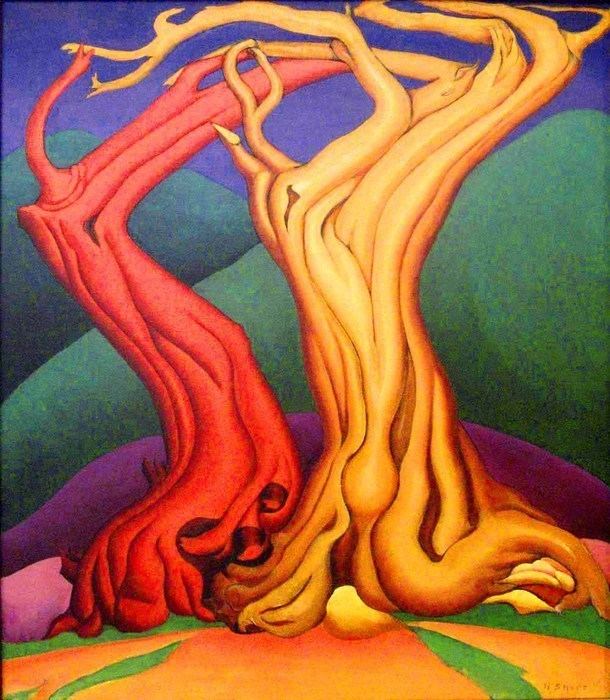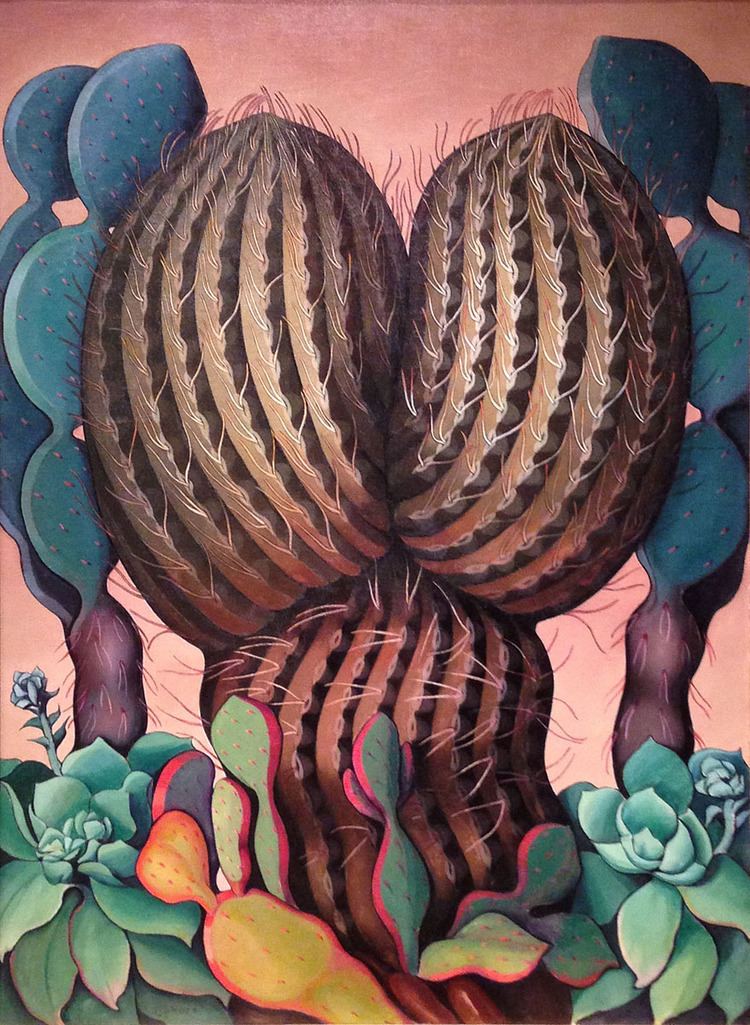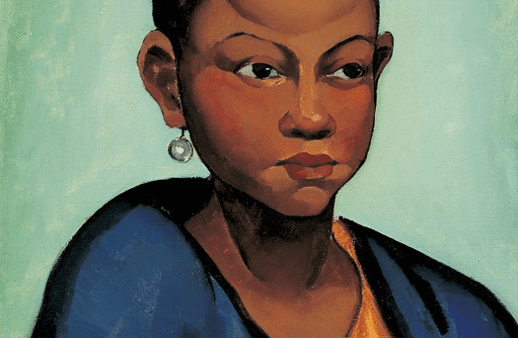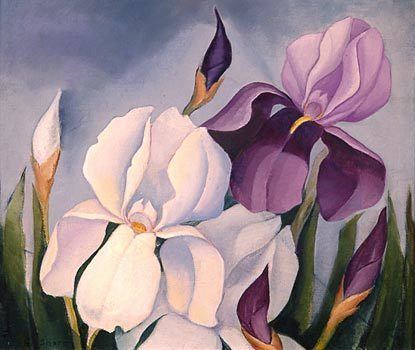Name Henrietta Shore | ||
 | ||
Education Art Students League of New York Artwork Cypress Trees, Point Lobos, The green mug | ||
Henrietta Shore (January 22, 1880 – 1963) was a Canadian-born artist who lived a large part of her life in the United States, most notably California.
Contents
Early life

Shore was born in Toronto, Canada, to Henry and Charlotte Shore. She was the youngest of seven children. She was drawn to both painting and nature at a young age, remarking "I was on my way home from school and saw myself reflected in a puddle. It was the first time I had seen my image completely surrounded by nature, and I suddenly had an overwhelming sense of belonging to it—of actually being part of every tree and flower. I was filled with a desire to tell what I felt through painting." Shore's mother supported Shore's artistic ambitions, but advised her to learn practical matters as well. After taking a domestic education class, at the age of 15, Shore began studying painting with the Canadian Impressionist Laura Muntz Lyall. Her works at this time are mostly genre scenes and thus conform to subject matter that would have been popular in Toronto's traditional art scene during the period.
Toronto, Europe, and New York: 1900–1913

Between 1900 and 1913 Shore travelled back and forth between Toronto, Europe and New York. It was during this period that she enrolled in the New York School of Art and studied under William Merritt Chase and Robert Henri, often spending half the year in New York. Henri's Ash Can School aesthetic influenced Shore's work during this time. His impact can be seen in subject matter and looser more painterly works such as Negro Women and Children from 1910-1915 currently in the National Gallery of Canada. During this time Shore established a reputation for herself within the Canadian art community as a promising young painter. She taught classes, had solo shows at galleries in Toronto and showed in group exhibitions in Paris, London and Liverpool.
Los Angeles: 1913–1920

In 1913 Shore moved from Toronto to Southern California, settling in Los Angeles and becoming part of a small but influential group of early West Coast modernists. She quickly found success, winning silver medals at the Panama-California Exposition in 1914 and 1915 in San Diego. Shore also showed work in juried exhibitions of the California Art Club to positive reviews. One 1916 review published in the Fine Arts Journal grouped her under the label of "the modernists" and declared her one of the best artists of the group among those who studied with Robert Henri. Of her work the reviewer comments, "Miss Shore tempers her pigment with intelligence and understanding, and brings to her work an acute knowledge of psychology as well as sound technique, a thorough art training and a rare artistic perception. Her exceptional canvas, called "Mother and Child," is unquestionably one of the real gems of the exhibition." In 1916, Shore was a founding member of The Los Angeles Modern Art Society along with Bert Cressey, Meta Cressey, Helena Dunlap, Edgar Kellar and Karl Yens. Undoubtedly influenced by The Eight (Ashcan School) show in New York City, The Los Angeles Modern Art Society sought to give additional exposure to more experimental artists outside the juried shows of the California Art Club. The group's first show was held in the gallery of the Brack Shops. They held their second exhibition the following year in 1918. This show also included works from prominent East Coast artists such as Robert Henri, George Bellows, Maurice Prendergast and William Glackens. The Los Angeles Modern Art Society was short-lived, disbanding soon after their second show. Throughout the whole process, Shore remained close to her mentor, Henri, through letters. After the disbandment of the group, Henri consoled her, writing, "perhaps it is good that Societys die young while they are yet virtuous and useful. Some of the old ones have hung on long after those conditions and they stand as horrible examples." In 1919 Shore began showing with Caroline Bowles, Helena Dunlap, William Cahill, Edouard Vsykal and Luvena Buchanan under the name California Progressive Group.
New York City and return to Los Angeles: 1920–1926

In 1920 Shore moved to New York, working in a studio on West 57th Street. During this time her work changed radically, morphing from painterly scenes of everyday life to colorful, close-up abstractions. It has been suggested that the change in style may be a result of exposure to other modernists working at New York during the time, such as Arthur Dove, Charles Demuth, and Georgia O' Keeffe. In 1923 Shore and O'Keeffe showed in the same month. Shore at Ehrich Gallery and O'Keeffe at the Anderson Galleries. Critics reviewed both shows together, attributing the similarities in their works (both abstracted nature scenes) to a female sensibility. Their works were framed by their gender, said to showcase "smothered passion" and "dark destiny or original sin." The reduction of her work to her gender deeply bothered Shore, who intended to express metaphysical themes through incorporating Eastern philosophy and Theosophy. In 1923 Shore returned to Los Angeles where she continued to work and exhibit. She opened a gallery/restaurant called Studio Inn.
Meeting Ed Weston and Mexico: 1927–1930
In 1927 Shore was introduced to photographer Edward Weston. Weston was struck by his first encounter with Shore's work, saying "Shore now realizes a fusion of her own ego with a deep universality...When she paints a flower she IS that flower." They quickly became close friends. Her paintings of sea shells attracted and influenced him and he borrowed some of her shells for his photographs. Shore was his senior, 47 to his 40 and at that time a much more established artist. On Weston's urging, Shore travelled to Mexico with her friend Helena Dunlop. It was in Mexico that she was introduced to lithography, a medium which continued to work in upon her return to California. Her stay in Mexico most certainly influenced Shore's work, as can be seen in paintings like Women of Oaxaca in which a line of women in traditional Tehuantepec clothing carry black water jars on their heads.
Carmel: 1930–1950
At the age of 50, Shore moved to Carmel, then a small art colony and resort, following in the footsteps of Weston, who had moved their shortly before. The natural beauty of Carmel provided Shore with ample painting inspiration. Shore lived in Carmel for the rest of her life. During this period she exhibited locally at the Carmel Art Association, the Legion of Honor, and the de Young Museum. She also had shows in New York and Paris. Despite these shows, Shore struggled financially during the Depression and slipped into relative obscurity, just as Weston began to achieve fame. Like many artists during this time, Shore relied on Works Progress Administration commissions for income. In 1936 she received a commission for six murals from the Treasury Department's Section of Fine Arts (from funds they received from the WPA). These murals, like many WPA commissions, focus on scenes of industry and work. Shore painted four lunettes for the Santa Cruz Post Office: Fishing Industry, Limestone Quarry Industry, Artichoke industry, and Brussel Sprouts Industry. She painted Artichoke Pickers in the Old Customs House in Monterey and Monterey Bay 1880-1910 in the Monterey Post Office. These murals are her last prominent works.
Later life and death 1950–1963
Shore spent her last years in poverty. She had to sell her Weston photographs to survive and became increasingly depressed. Sometime in the late 1950s her neighbors had her institutionalized. Her very dear friend Jehanne Bietry Salinger said about the matter, "some so-called 'do-gooders' went to her studio, found it disorganized, and had Henrietta committed to an asylum. If I had been in Carmel, I would never have permitted it, since she was in no way insane. I still can not think about this without being heartbroken." Shore died at the age of 83 in a mental institution in San Jose, California in 1963.
Legacy
Unlike Edward Weston and Georgia O'Keeffe, Henrietta Shore and her work mostly fell into obscurity after her death. A posthumous show of her work was organized by the Carmel Art Association. Her unsold work was divided between her surviving nephews, Osborne Shore Hollinrake and Wendall Shore.
